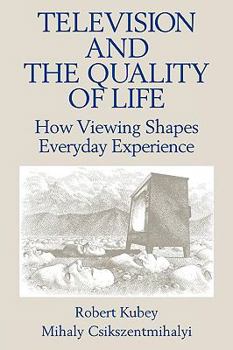Television and the Quality of Life: How Viewing Shapes Everyday Experience
Employing a unique research methodology that enables people to report on their normal activities as they occur, the authors examine how people actually use and experience television -- and how television viewing both contributes to and detracts from the quality of everyday life. Studied within the natural context of everyday living, and drawing comparisons between television viewing and a variety of other daily activities and leisure pursuits, this...
Format:Paperback
Language:English
ISBN:080580708X
ISBN13:9780805807080
Release Date:May 1990
Publisher:Routledge
Length:306 Pages
Weight:1.15 lbs.
Dimensions:0.8" x 6.0" x 9.0"
Customer Reviews
4 ratings
All too true
Published by Thriftbooks.com User , 15 years ago
This is a wonderful book! It also with Four Arguments for the Elimination of Television have inspired much of my research and thought.
Who watches TV?
Published by Thriftbooks.com User , 19 years ago
This book is an exploration into the effect television has on the viewer's state of mind. The organization and style of the book read very much like a dissertation that has been reworked slightly for publication. The style of writing is very academic, and is geared to academic rather than general audiences. The first two chapters are pure literature review covering information reception and previous research about television viewing. The next chapter discusses the research methods. The main study involved a group of about 100 adults living near Chicago in the 1970s, who were asked to keep activity and mood diaries over the course of a week. The data from this study were combined with data from a number of other studies that examined television viewing habits of mostly Americans and Canadians. The remaining chapters cover various aspects of the results and discussion, including: how television fits into the scheme of leisure time, how television affects viewer's moods, how television affects family life, why some people view more than others, uses of television, television and marketing, and television and personal growth. As with a dissertation, sources are cited within the text and each chapter has extensive endnotes for further explication and references. The questionnaires used in the study are reproduced in the appendices. A full list of references is included, as well as an author index and a subject index. So what did they find out from their study about viewers in the 1970s? First, participants in the study watched about 1.4 hours of TV each day, which represented 6.6% of the participants' total waking hours. TV viewing was the most time-consuming activity engaged in at home, and TV viewing absorbed 40% of all leisure time, or another way to look at it, 25% of all time spent at home was spent watching TV. Ninety-three percent of TV viewing occurred in one's own home. Most viewing occurred between 7:30 and 10 PM on weekdays. Twenty percent of the time, people watched TV because they had nothing better to do, giving TV the highest nothing-better-to-do ranking of major home activities including reading, eating, cooking, chores, talking, and grooming. People tend to watch more TV when they are in a bad mood or when they just want to relax with something mindless. When compared to work, other leisure activities, or meals, participants reported that TV required the least concentration, challenge, and skill of all, and people were most passive when watching TV than when engaging in any other leisure activity. Watching TV had the lowest mood and activation ranking of fifteen common daily activities that included such items as resting, transit, and chores. When compared to sports and other leisure activities, it was found that TV required much less concentration during the activity, and that participants found it harder to concentrate after watching TV than before they began. TV viewing is quite relaxing while participants enga
Landmark work, non-judgmental, empirical...
Published by Thriftbooks.com User , 22 years ago
This is one of the most intense and empirical studies of how people relate to television (not focusing on television's content), nothing judgmental here folks, the data is presented in text and charts. We get to see the surveys, the responses, we are informed of the study methods used...Various psychological traits are measured before, during, and after television viewing in the subjects homes. Things like concentration, cheerfulness, challenge, memory, and other traits are measured at various times using a self-reporting mechanism. The merits and faults of the methods used to study the subjects are also discussed. The book is intense.I'm sorry I can't encapsulate it better than this. The authors (Mihaly and Robert) do an extremely admirable job of presenting the information in a readable and complete format.Again, it should be stressed that this study was empirical. No judgements are made. Content of television was not part of the study, content of the subject's psyches was.A landmark work.
THE FLOW NETWORK
Published by Thriftbooks.com User , 26 years ago
Take steps towards enhancing the quality of your life - explore FlowNet and exchange ideas and experiences associated with Mihaly Csikszentmihalyi's Flow theory @ http://www.flownetwork.com




